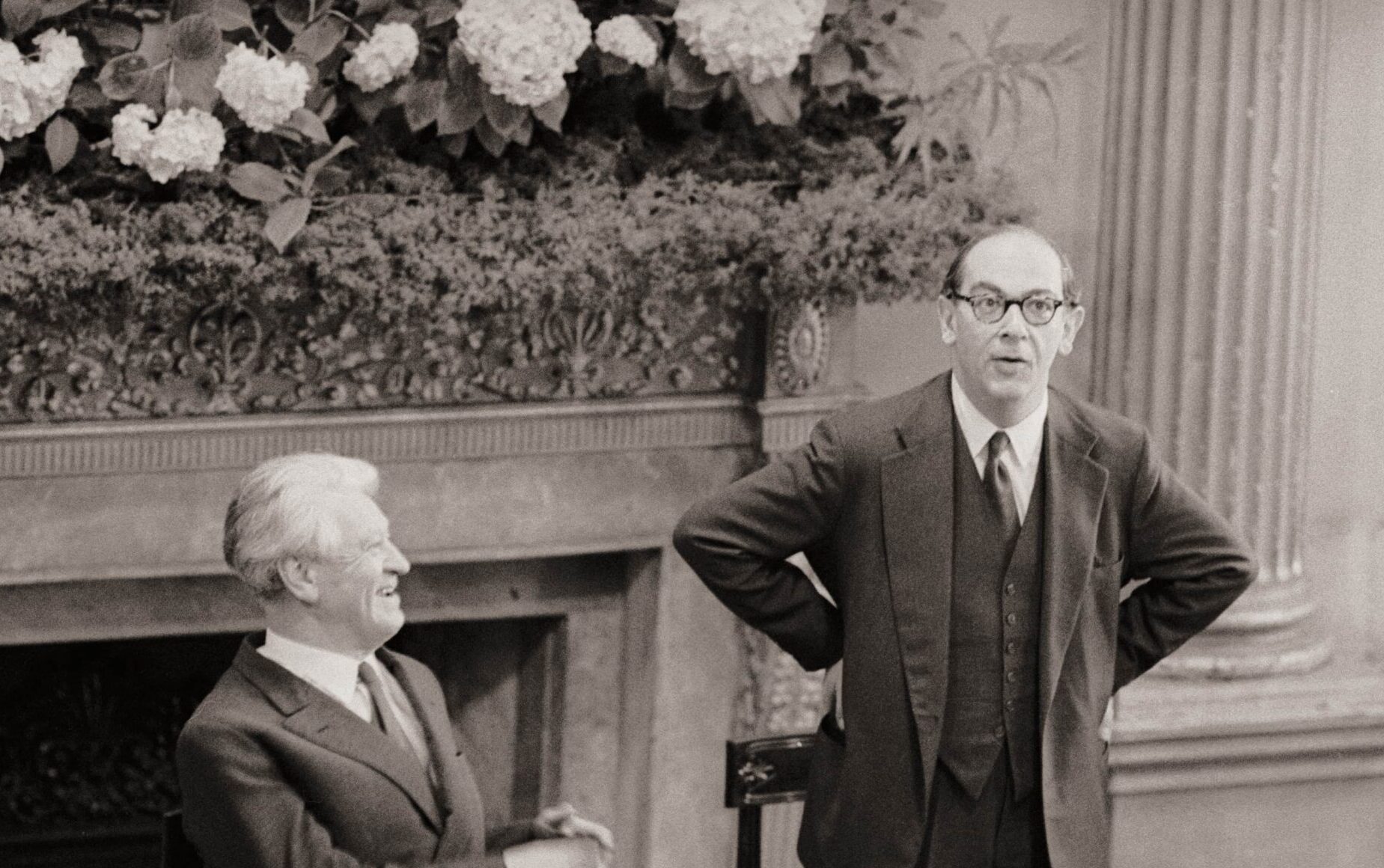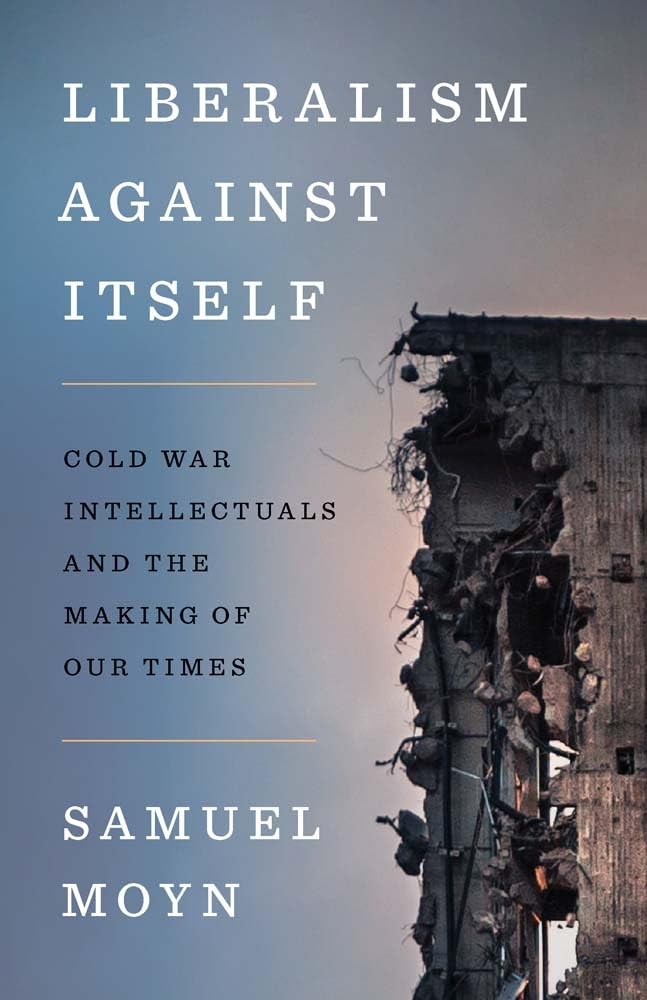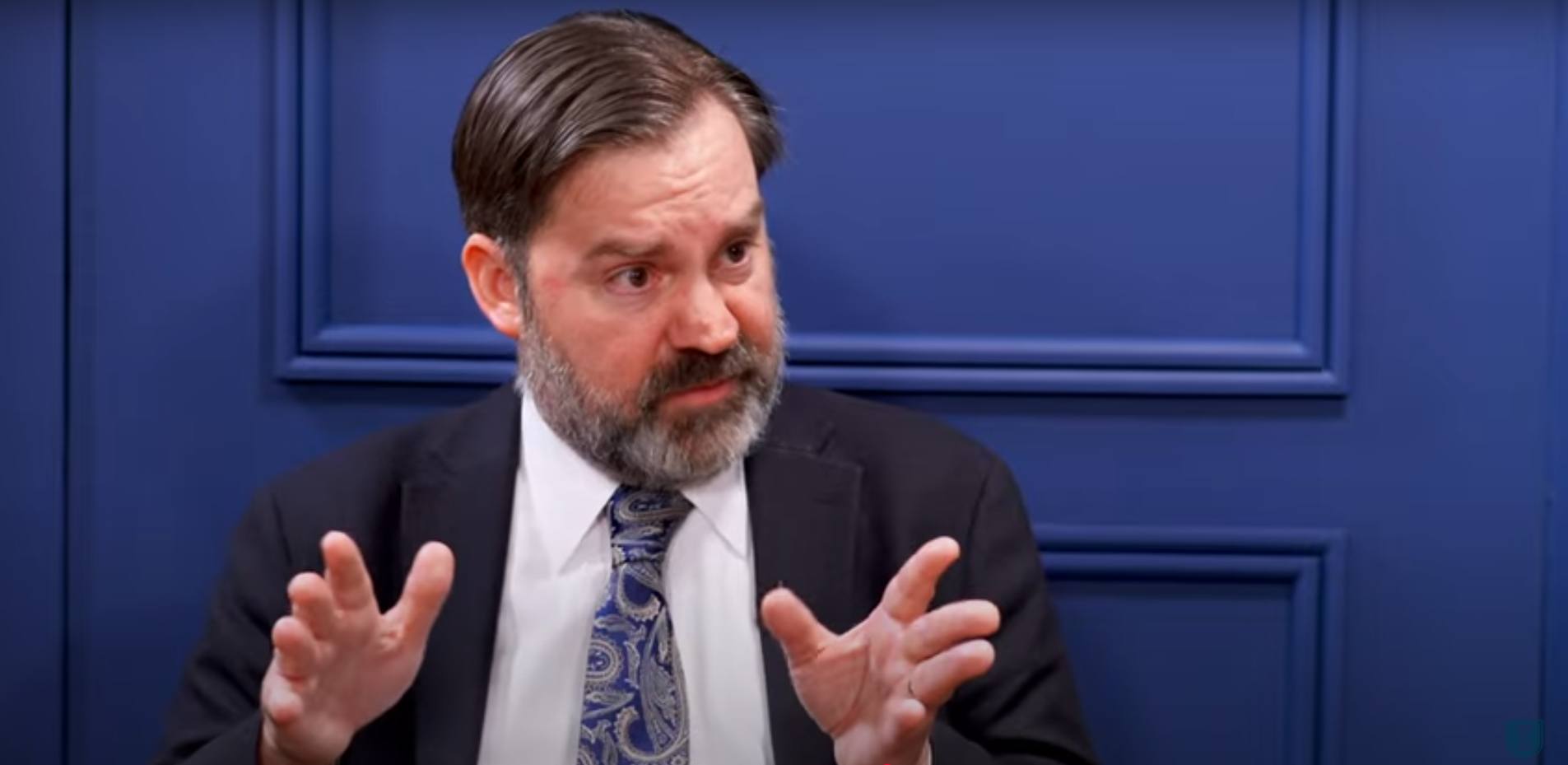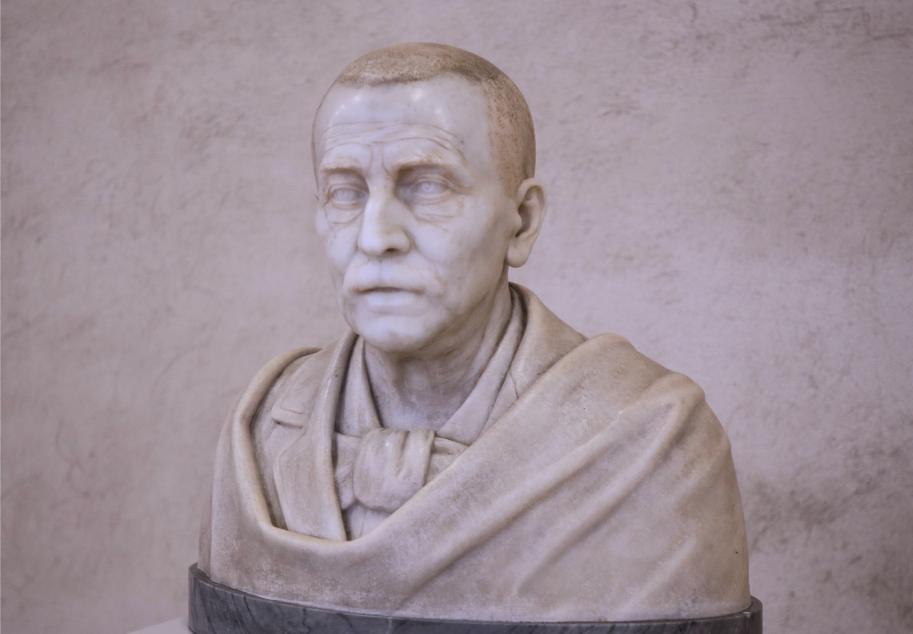Samuel Moyn, a distinguished intellectual historian who teaches law and history at Yale, characteristically stresses discontinuity in his work, and Liberalism Against Itself is no exception. After the defeat of the Axis Powers in World War II, the wartime alliance of the United States and Britain with Soviet Russia soon broke down, and the Cold War began. Moyn holds that the Cold War liberals who defended the West in this new confrontation broke radically with pre–World War II liberalism, and he does not like this change. Prewar liberalism affirmed human creativity and sought to achieve radical reforms of an economy dominated by wealthy corporate interests. It looked with favor on mass participation in politics, seeing Franklin Roosevelt’s New Deal as an example of what could be achieved and seeking to extend it.
Cold War liberalism, by contrast, viewed the masses with fear, seeing both the Nazis and Communists as two branches of totalitarianism and treating with skepticism not only the Russian Revolution but often the French Revolution as well. Human limits rather than human powers were at the forefront, and original sin, or secular analogues of that Christian doctrine, became popular. Rousseau, Hegel, and Marx were expelled from the liberal canon but not forgotten; rather, they became part of the “anticanon”: “Anticanons—past books, figures, or movements that are anathematized in order to define and stabilize traditions—are of supreme relevance to canonical work. The elements of anticanons are preserved as counterexamples to avoid: ‘their errors’ are ones ‘we would not willingly let die,’” he writes.
Although the Cold War is over, today’s descendants of the Cold War liberals continue their emphasis on limits. They write book after book denouncing Trump for his disregard of customary democratic procedures, failing to see that both they and the supporters of Trump accept the basic institutions of corporate capitalism and do not seek radical social reform.
Moyn makes clear his verdict on liberalism of this sort:
As it did when it was founded, Cold War liberalism continued to forsake the emancipation the Enlightenment began, any perfectionism that held out creative self-making as the highest life and constructed the conditions for its exercise, and a progressive story about achieving both in historical time. The results left blighted lives behind, as the oppressions of class, race, and gender made it increasingly unclear why this liberalism was worth defending. . . . The task for liberals in our time is to imagine a form of liberalism that is altogether new. If they don’t, it does not seem likely that they will see their creed survive—and anyway, survival is not good enough.
Liberalism Against Itself has already attracted much attention. Many reviewers have defended the Cold War liberals, and it is easy to surmise that most readers of Modern Age will not join Moyn in his call for radical reform—at least not the sort of radical reform he has in mind. Although I too disagree with many of Moyn’s proposals, the main criticism I have of the book does not concern these. Rather, my principal objection is that Moyn has put to one side a key tenet of Immanuel Kant, one of the greatest Enlightenment philosophers, namely that one must support one’s views by reasoned argument. Instead, he simply announces a stance: “This is my take on things,” he says in effect. “Let’s rally to it.” What, for example, are the arguments that show that human beings have creative powers of the sort he attributes to them? What arguments show that if indeed humans have these powers, they ought to be expressed in the way Moyn wants them to be? What are the arguments for radical social reform? Moyn does not tell us. I do not say that he could not do so, but he has failed to do so in this book. By this failure, he shows his similarity to the postwar existentialists whom he criticizes: he too adopts a stance and leaves it at that. He gives those who oppose his policy proposals no reason to change their minds.
Despite this problem, the book is well worth study because of Moyn’s often incisive comments about the writers he considers, based on great learning and close reading. It consists of six chapters, originally delivered as the Carlyle Lectures on the History of Political Thought at Oxford University in 2022, along with an introduction and epilogue. The lectures cover Judith Shklar, Isaiah Berlin, Karl Popper, Gertrude Himmelfarb, Hannah Arendt (not a Cold War liberal but close to one, Moyn thinks), and Lionel Trilling. Some of these people are discussed in more than one chapter, and Moyn comments on many others as well, including Friedrich Hayek and the historian Jacob Talmon.
Moyn has been greatly influenced by the dissertation of Judith Shklar, published in modified form as her first book, After Utopia, in 1957. He calls Shklar, who taught in the government department at Harvard for decades, his “guide”: her work “remains the greatest anatomy and critique of Cold War liberalism ever published.” It is here that Moyn finds his fundamental criticism of the Cold War liberals: they retreated from the Enlightenment’s emphasis on creative human powers and, in their fear of the masses, embraced “fatalism.” “Shklar dripped scorn on the fact that Talmon and other neoliberals, in their explanation of why liberty could not survive democracy or redistribution, adopted the same historical determinism they castigated in Marx. Not that a liberal needed to apologize for a concern about personal freedom and limited government. But for Cold War liberals, ‘an inner urge to fatalism has obliterated all . . . distinctions among actual forms of government.’” It does not detract from her achievement, Moyn holds, that Shklar in her later work embraced the limited perspective on human possibilities that she had earlier condemned.
Shklar also foresaw that the fear of mass politics would lead the Cold War liberals not only to reduce their demands for economic and social reform but also to come close to support for capitalism along the lines of Hayek. As readers may imagine, I do not view this as quite so unfortunate a development as does Moyn, but I shall not quarrel with him. Still, he should not follow Shklar in grouping Ludwig von Mises with “Austro-German ordoliberalism,” a movement he strongly opposed. (The ordoliberals, who included Walter Eucken and Alfred Müller-Armack, supported government regulations to supplement the free market.)
Moyn finds Isaiah Berlin to be a slippery character. Before World War II he took a favorable view of the Enlightenment, but afterwards he questioned its optimistic assumptions in essays and lectures while misleadingly writing to friends that he still identified with it. “Berlin went so far in these gestures that he began to deploy an increasingly familiar, not to say repetitious, strategy: denounce the Enlightenment in public for spawning the Soviet Union, and then reassure aggrieved or worried correspondents that the Enlightenment mattered for his own liberalism too,” Moyn writes.
Moyn does credit Berlin for his analysis of Romanticism, but about Karl Popper his verdict is less mixed: “Popper’s accidental but egregious contribution to Cold War liberalism was to achieve the liquidation of its Hegelian and historicist legacy.” The discussion of Hegel and Marx in the second volume of The Open Society and Its Enemies “relied on the spottiest possible knowledge of their works.” In defending Hegel against Popper’s stress on Hegel’s historicism, Moyn notes that earlier critics of German philosophy, such as George Santayana and John Dewey, had not stressed Hegel’s alleged commitment to historical laws, and, he says, “in his English answer to the earlier American complaints, The Metaphysical Theory of the State (1918), L. T. Hobhouse ignored claims on history altogether.” But Hobhouse’s book is not a defense of Hegel; it is a criticism of the neo-Hegelian Bernard Bosanquet.
Moyn has astutely noticed a feature of Popper’s thought that most readers miss. Popper saw an affinity between his own opposition to deterministic historical laws and the views of theologians who argue that God’s will for history is unknown to us:
“Then there was the extraordinary chapter in Popper’s The Open Society and Its Enemies celebrating neo-orthodox Augustinianism for forbidding neo-Pelagian historicism. From a religious perspective, Popper wrote, historicism cruelly liquidated the individual’s inner significance and risked the ‘blasphemy’ of exonerating ‘the history of international crime and of mass murder.’” In the discussion that Moyn mentions, Popper cites Karl Barth favorably; Popper’s remarks about John Macmurray’s work The Clue to History should also be noted. Barth, often considered the greatest twentieth-century Protestant theologian, viewed God as “wholly other”; but Macmurray, sympathetic to Marxism in the 1930s, believed that human history is guided by God.
The intellectual historian Gertrude Himmelfarb wrote a pioneering study of Lord Acton, whose strict moral appraisal of historical characters and defense of the American Revolution won her admiration, and Moyn gives a very good presentation of her differences with the Cambridge historian Herbert Butterfield, who disagreed with Acton and thought that historians, at least in most circumstances, should avoid moral appraisals that distinguish good people from evil ones; as he saw it, we all stand under God’s judgment. She excoriated Butterfield for favoring making peace with Nazi Germany in 1940 and for insufficient ardor for the Cold War. Moyn himself disagrees with American foreign policy in the Cold War, probably to a substantially greater extent than Butterfield, but he misses how decisive Butterfield’s appeal to original sin was in his advocacy of peace. Butterfield’s comments about the origins of World War II are better seen as a defense of peaceful relations between states, based on Augustinian grounds, than as an excuse for leaders of states to act immorally in the name of “realism,” as Moyn interprets his remarks.
For Augustinianism Moyn has no use. It leads to a withdrawal from the world and a denial of human powers, he says. Yet Himmelfarb’s husband, Irving Kristol,
like many other Cold War Jews, was looking for an exit from claims on history. . . . Cold War liberals like Kristol and Himmelfarb—though essentially non-observant—thus fit well with Hannah Arendt’s quip that Orthodox Judaism was the Judaism that she didn’t practice. It is worth expanding her point: for a striking number of Cold War liberals, Augustinian neo-orthodoxy was the Christianity they wanted to see the West adopt. Only Judith Shklar’s skepticism of Cold War religiosity in After Utopia offered a caustic and helpful counterpoint to the mood. . . . She argued that Christian thought of the mid-twentieth century largely offered up another version of the fatalism that reigned in her time. And her contempt for how liberals allowed themselves to be caught up in it was undeniable.
Once more there is no argument, from either Shklar or Moyn, that these fatalistic views are mistaken but merely the (quite accurate) point they both make that these positions do not comport well with the liberal idea that human beings have the power to bring about reforms that they favor.
All the writers Moyn lectures about were of Jewish descent, though they were non-observant, and this leads him to another criticism of them. Except for Popper, they all viewed progressive politics in Israel much more favorably than they did that of other countries, and they supported Israeli foreign policy with little attention to the rights of Palestinians: “More than the earlier votaries of white freedom in the tradition of liberal imperialism, Cold War liberals could understand the toll of racialized victimhood—yet it seemed to make them no more empathetic to its global toll. Zionism, the one statist liberation movement they supported, therefore goes to the heart of their contradictions. Jews in the Middle East were allowed a form of politics that was ruled out by the libertarian breviary developed for the West in the face of the Soviet enemy.” Although his account of Hannah Arendt is quite critical, he praises her denunciation of Zionism after her earlier support for it. Like Judah Magnes, an influential American Reform rabbi and the first chancellor of the Hebrew University in Jerusalem, she favored a binational state and was alarmed by what she saw as the fascist proclivities of Revisionist Zionism, a movement led by Ze’ev Jabotinsky which called for Jewish control of all of Palestine and Transjordan.
Moyn finds Lionel Trilling to be the “shrewdest Cold War liberal” in his grasp of the complexities of literary and intellectual movements, but, like the others, he took a cramped view of human powers. This stemmed from his interpretation of Freud, which emphasized the limits to reform if Freud’s theories of aggression and the death instinct were accepted: “Far from being a liberator on behalf of love and sex, then, Freud was a stern moralist for whom aggression and death cast an inevitable shadow over love and life and imposed strict limits on reform.”
Readers of Samuel Moyn’s in many ways remarkable book will get a clear view of how a highly gifted scholar sees these Cold War intellectuals. But if they want arguments in support of his opinion that these liberals were less “progressive” than they should have been, they will need to look elsewhere.
















